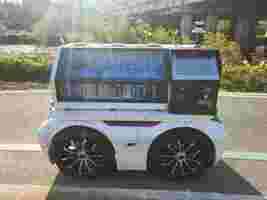The state of the autonomous vehicle industry in 2021
This article was written by Marc Amblard, Founder & Managing Director, Orsay Consulting on The Urban Mobility Daily , the content site of the Urban Mobility Company, a Paris-based company which is moving the business of mobility forward through physical and virtual events and services. Join their community of 10K+ global mobility professionals by signing up for the Urban Mobility Weekly newsletter . Read the original article here and follow them on Linkedin and Twitter .

Autonomous Vehicles (AV) hit the bottom of Gartner Hype Cycle’s trough of disillusionment in 2019-2020. Since the middle of last year, we have observed an acceleration in funding and valuation which has led to a few acquisitions. More importantly, this is further singling out a few major players which accelerate their technology development and the deployment of pilots. In addition, these select companies are aggregating an increasing number of OEMs, both light vehicles and heavy trucks, around them — the latter are shifting more of their focus to EVs and software development.
AD system majors have raised billions in the last few months
In the past 9 months, five of the main autonomous driving system (ADS) developers have raised over $4B in total. Cruise benefited from the largest round with $2.75B raised largely from Microsoft and retail giant Walmart at a $30B valuation! Likewise, Aurora, Pony.ai, WeRide and Didi’s AV entity each raised $300M to $400M in the last few months.
We can also suspect that the OEMs that have engaged in partnerships with these companies (see below) have committed to making hefty financial contributions for the right to access the tech for pilots in the mid-term and for production in the longer term.
Another path to raising funds is to go public. Sino-American autonomous trucking startup TuSimple was just introduced on the US stock market, raising about $1.1B at an $8.5B valuation. Similarly, Argo AI, in which Ford and Volkswagen each own 40%, is considering doing the same later this year. This could reduce the pressure on the two OEMs as Argo AI needs to secure its financial runway.


Elsewhere in the AV space, Lidar companies have been very active on the financial front as well. At least six of them have gone public, reverse merging with SPACs and raising over $2B cumulatively over the last 9 months. They have taken advantage of the SPAC wave and of renewed hype in the AV space, managing to hike their valuation to between $1.4B and $3.4B.
The above valuations benefit from a boom in financial markets but are difficult to justify, especially for Lidar startups which have a narrow value proposition and overlapping market ambitions. Nevertheless, these valuation enable significant cash injections (with limited dilution), which will accelerate the development of AV solutions for passengers and goods transportation.
AD system majors are integrating vertically
The large fund raising rounds also provide developers with the means to better master key components of their solutions. Whereas Waymo developed their own Lidars, radars and cameras in-house and specify their compute hardware, other have progressively integrated sensor startups. Last year, Cruise acquired Astyx (radar), complementing Strobe (Lidar) which was purchased in 2017. Similarly, Aurora gained control of Lidar-startups Blackmore (2019) and Ours (2020).
ADS majors have also all developed their own simulation and mapping solutions and are specifying their compute platform in order to ensure optimal overall integration. Pure ADS players such as Waymo, Argo AI or WeRide will provide reference designs for the combination of sensors, compute and mapping tech to their vehicle OEM customers.
For a few players, vertical integration goes beyond AD technology to include vehicles. On the passenger side, Cruise (with GM and Honda) and Zoox have presented their robotaxis and intend to operate the mobility business. Likewise Navya, Easymile and others launched their own autonomous shuttles years ago. On the goods transportation side, Nuro and Neolix have started operating their own last mile delivery vehicles.
Earlier this year, Cruise made an interesting move with the acquisition of Silicon Valley-based Voyage, which can be considered downstream vertical integration. This cannot be justified by the latter’s AD tech but rather by its market access — Voyage is operating autonomous shuttles in retirement villages in the USA. These locations will likely be used as test beds for Cruise’s Origin robotaxi (above).
Aggregation around a select group of AD system majors
OEMs have partially reallocated their AV R&D budget to accelerate EV development, a must-have given CO2 regulations and market trends, as well as to build-up their software capabilities, another critical move. Given the sums and duration required to bring robust AV tech to market — ADS majors reportedly spend $500M to $1B per year — OEMs are better off joining expert teams for their ADS tech.
As a result, we have observed the aggregation of OEMs around major ADS developers in the past months (diagram below). Most ADS majors partner with either passenger vehicle or truck OEMs depending on their focus. However, Waymo and Aurora have managed to sign collaborations with both types of OEMs to match their dual objectives.
While OEMs are by and large putting their AV future in the hands of ADS majors, they continue to advance their driving assistance game on a parallel, incremental path. Most are deploying Level 2 solutions, and a couple are venturing into Level 3, namely Honda and Mercedes after Audi’s attempt was constrained by regulations. But the longer term goal of reaching Level 4 will involve some sort of partnership with ADS developers.
In summary, it is becoming clear that the capital-intensive development of ADS and AV technology will be handled by a handful of companies which will either offer ADS to OEMs or will develop and operate fleets of autonomous vehicles.
Do EVs excite your electrons? Do ebikes get your wheels spinning? Do self-driving cars get you all charged up?
Then you need the weekly SHIFT newsletter in your life. Click here to sign up .
If this self-driving library came to my town, maybe I’d read a damn book
I love reading books and that’s why I have a membership card for my city’s public library. Do I visit it often? No, I don’t. I’m normally too busy or lazy to leave the house just for that.

For the same reasons, I have a stash of books that I did manage to borrow from the library, which I return long after the due date and end up paying some pretty big fines.
But what if I could have access to books while strolling around the city to get a coffee or something? That’d definitely make it easier.
So it’s too bad that I’m not living in Seongnam City in South Korea, where self-driving library robots will be demonstrated on November 19.


Loaded up with 100 books, the autonomous bot will move along a 180m path across the Tancheon Park promenade.
Anyone with a membership card issued by the Seongnam City Public Library can borrow up to two books and return them within two weeks to the designated return boxes installed on the promenade.
Although a self-driving vehicle isn’t allowed to operate on sidewalks or crosswalks, and neither within parks if it weighs more than 30kg, the Ministry of Trade, Industry and Energy has granted an exception to Seongnam City and approved the robot‘s promotion as a regulatory special case for demonstration.
The city plans to run a pilot operation at Tancheon promenade and Yuldong Park by 2024, and then expand and operate library robots throughout the city, including neighborhood parks, residential areas, and apartment complexes by 2030.
In October, Seoul Metropolitan Library, operated by Seoul City, opened an automated library at the subway station City Hall.
With over 1,000 books, it’s the country’s largest smart library, designed to make book rental services easy, accessible, and safe, especially amid the pandemic.
In the press release , the Chief Librarian of the Seoul Metropolitan Library noted:
Promoting libraries and reading culture in a digitalized era is challenging, to say the least.
Data released by Statistics Korea in September showed that, in 2020, the average number of visitors per library was down 69.5% year-on-year and the number of loaned books decreased 14.8%.
And my guess is that the numbers are unlikely to go up in the future.
So, perhaps South Korea has got it right and the use of automated book rental services, such as smart libraries or self-driving robots, can contribute to the promotion of reading actual books.
And personally, I can’t wait to see a cute library bot strolling across my street.
Uber looks to prevent drivers from seeing destinations — it’s a dick move
According to the San Francisco Chronicle , Uber is thinking about stopping its drivers from being able to see the destinations and potential prices of ride requests.

Yet again, it shows the ride-hailing Übermensch doesn’t really prioritize its drivers. It’s classic poor form from Uber, and I’m going to explain why.
As the Chronicle points out, last year, Uber began letting its drivers see ride destinations and pricing information before accepting rides. In reality, this was a thinly veiled attempt to make it seem like the company was giving its workers some kind of independence and control over how they operate.
With the latest news, it seems this was nothing more than ballot posturing in preparation for Prop 22 , which passed last November.
Prop 22 was a huge campaign, involving not just Uber, but its ride-hailing competitor Lyft, and food delivery service DoorDash. In short, Prop 22 was designed to persuade the Californian voting public to officially classify gig-work drivers as independent contractors.
It was a direct challenge on AB5 legislation, which was intended to provide gig-workers with important employment benefits and insurances.
Ultimately, the voting public sided with Uber. Probably for one simple reason, Uber said rides would get more expensive if it had to pay its drivers benefits, and a minimum wage.
Indeed, Uber was and seemingly still is toeing the line of what is a sustainable business, admitting that letting its drivers see destinations and prices has hurt its business.
As a result of being able to see what the most desirable rides are, Uber drivers have been selective over what rides they accept in order to maximize their earnings. The company said drivers have declined more than 80% of ride requests.
Indeed, Uber is stuck between a rock and a hard place right now.
On one hand, it’s not a good look at all. Flip-flopping on its previous decision, which was designed to give drivers more control over how they worked, only to remove that control completely flies in the face of what Prop 22 supposedly embodied.
On the other hand, it’s a terrible customer experience not being able to fire up the app, and get a ride quickly and easily. That also, is very far from what Uber has promised.
“It’s been a pattern, a bit of a tease for Uber to give drivers features they want and then take them away,” Oliver Campbell, who runs the Ride Share Guy blog and podcast, told the San Francisco Chronicle.
Drivers have wanted this feature for a while and will be pissed off if they lose it, he added.
Uber has a difficult decision to make. It can stand by its previous decision to give drivers more control over how they operate and let them select rides. It’s a factor which ultimately helped promote Prop 22. In this case, it will likely continue to watch rides get rejected and no doubt lose customers as a result of poor service.
Or it can stop drivers from seeing destinations and prices, in an attempt to decrease the number of rejected rides. If it does this, it will contradict itself over its previous decisions to protect the independent status of its drivers, and take another step towards becoming a regular ol’ taxi firm .
Do EVs excite your electrons? Do ebikes get your wheels spinning? Do self-driving cars get you all charged up?
Then you need the weekly SHIFT newsletter in your life. Click here to sign up .